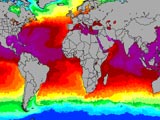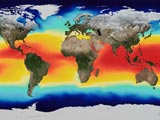Water Temperature Index

How cold the water feels is going to depend on a few factors. Obviously is the sea temperature itself, but there is also a high degree in variation between individuals, plus it depends on what you are doing. If you are doing something very active like swimming you will be less affected by the water temperature than you might be if you are surfing, where a lot of time is spent waiting for waves.
It is also the case that people can become acclimatised to colder water. So if you go for a dip in the sea all year round then you will cope a lot better when the mercury heads south. This is also likely to be the case for those who hail from sunnier climes; if, for example, you grew up in Hawaii, it is likely to be something of a shock if you took a dip in Nova Scotia, even in mid-summer.
Another important factor is how much spare fat you’re carrying. This was starkly illustrated in the case of an Icelandic fisherman who survived for 6 hours in 5C (41F) water after his boat sank. No one else on the boat did, and the only reason he did was because he was clinically obese. In effect he had the physique of a seal.
To give an indication of how cold various water temperatures will feel if you were to swim in them we have compiled a table. As something to compare, a competition swimming pool will be heated to 25-28C (77-82F).
| Temperature | How does it feel | Description |
|---|---|---|
| 0-5°C (32-41°F) | Freezing! | Water temperatures this low will literally take your breath away and feel painful on the skin. Unless you are used to these kind of temperatures consider it dangerous. Even experienced ice swimmers will rarely last more than a couple of minutes. |
| 5-10°C (41-50°F) | Very cold | Dangerously cold unless well acclimatised and even then hypothermia will set in within half an hour. |
| 10-15°C (50-59°F) | Cold | Something of a shock to the system when you first get in and most people won't be able to tolerate for very long. |
| 15-20°C (59-68°F) | Chilly | A touch on the cold side. Fine for a quick swim or dip, but most people will be more comfortable in a wetsuit. |
| 20-25°C (68-77°F) | Pleasant | Whilst this will feel a touch chilly when you first get in most people will find it comfortable afterwards. Perfect for swimming and splashing around |
| 25-30°C (77-86°F) | Balmy | Swimming pool temperature, so ideal for swimming. However, may be a little warm for longer swims. |
| 30°C+ (86°F+) | Warm | This will feel warm from the moment you get in. If you’re too active there is a real danger of getting too warm and even heat stroke. |
What you must bear in mind when looking at these temperatures is that water will conduct away your body temperature 25 times faster than air. This is important because our body must maintain a temperature of 37°C (98.6°F). Whilst an air temperature of 20 C (68F) will feel quite warm, the same sea temperature would rapidly sap our body’s heat and over the course of several hours and lead to hypothermia – the lowering of core body temperature.
Of course wearing a wetsuit will make virtually any water temperature accessible. However, even a good wetsuit will only protect you from the cold for so long and, as I have found myself, you can easily start to become hypothermic.
 Yearly Sea Temperature Animation
Yearly Sea Temperature Animation  Guide to How Cold Water Temperature Feels
Guide to How Cold Water Temperature Feels  Sea Temperatures FAQ
Sea Temperatures FAQ